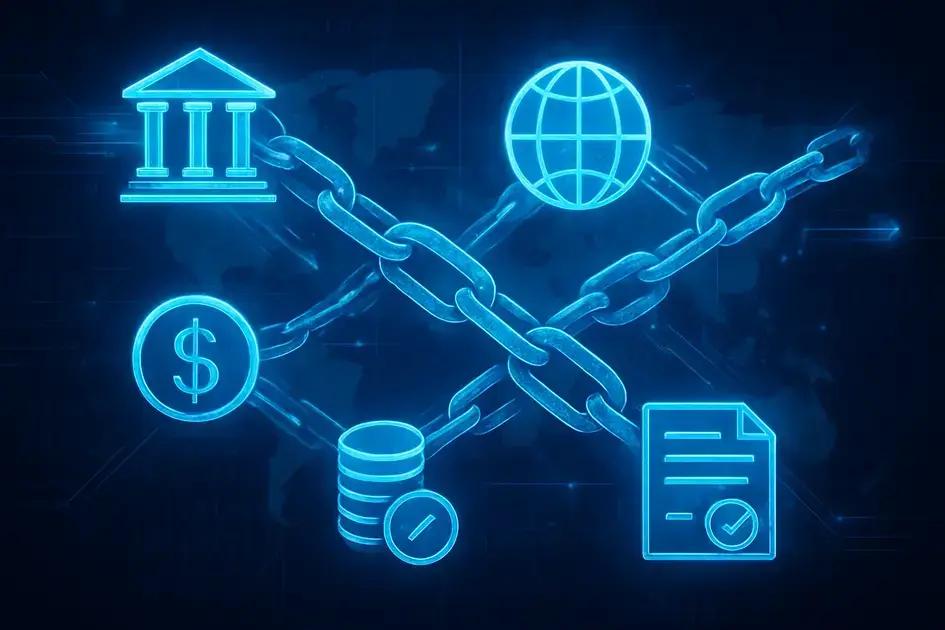Blockchain in finance is a decentralized digital ledger that enhances security, transparency, and efficiency by enabling faster transactions, reducing costs, and supporting innovations like smart contracts and decentralized finance.
Have you noticed how blockchain in finance keeps popping up everywhere? It’s not just buzz—this tech is quietly transforming the way money flows and trust is built. Let’s explore together why it matters and what could be next.
what is blockchain technology and how does it work
Blockchain technology is a decentralized digital ledger that securely records transactions across many computers. Unlike traditional databases controlled by a single entity, blockchain distributes data so that no single point can be altered without consensus from the network. This makes it highly transparent and resistant to fraud.
How Blockchain Works
Each transaction is grouped into a block, which is then linked to the previous block, forming a chain—hence the name blockchain. These blocks are secured using cryptography, ensuring that once information is recorded, it cannot be changed or deleted without approval by the network participants.
Key Components
Decentralization means data isn’t stored in one place but across many nodes worldwide. Consensus mechanisms, like Proof of Work or Proof of Stake, make sure all copies of the ledger agree. Smart contracts are programmable agreements that automatically execute when conditions are met, expanding blockchain’s potential beyond simple transactions.
This technology enables trustless interactions, meaning parties can transact without needing to trust each other or a central authority. This shift fosters increased security and efficiency, particularly useful in finance, supply chains, and more.
the role of blockchain in modern financial systems
Blockchain plays a growing role in modern financial systems by providing a secure, transparent, and efficient way to handle transactions and data. Traditional financial systems often rely on intermediaries like banks and clearinghouses to verify and process transactions. Blockchain technology simplifies this by enabling peer-to-peer transfers without needing a trusted middleman.
Increased Transparency and Security
Blockchain’s decentralized ledger allows all participants in the financial network to view the same transaction history in real-time. This transparency reduces fraud risk and improves auditability. Additionally, the cryptographic security behind blockchain makes unauthorized changes virtually impossible.
Faster and Cheaper Transactions
With blockchain, cross-border payments and settlements can happen much faster compared to traditional banking systems, which often take days. This is because blockchain processes transactions 24/7 without delays from intermediaries or business hours. The reduced need for middlemen also cuts down fees significantly.
Innovation in Financial Products
Blockchain enables the creation of new financial instruments such as smart contracts—self-executing contracts with the terms directly written in code. These automate complex processes, like loan issuance or insurance claims, minimizing errors and speeding up service delivery.
Furthermore, blockchain supports decentralized finance (DeFi) platforms, which offer services like lending, borrowing, and trading without traditional banks. This opens financial opportunities to a broader audience.
advantages of using blockchain in finance

Using blockchain in finance offers several key advantages that help transform how financial institutions and users manage money and transactions. One major benefit is enhanced security. Blockchain’s decentralized nature and cryptographic methods make it extremely difficult for hackers to alter transaction records or steal data.
Greater Transparency
All participants in a blockchain network share access to the same ledger. This means transactions are fully traceable, reducing errors and fraud. Transparency builds trust among users and regulatory bodies.
Improved Efficiency and Speed
Blockchain eliminates the need for intermediaries, reducing delays and costs. Transactions can be confirmed quickly, often in minutes or even seconds, compared to traditional banking systems that could take days.
Cost Reduction
Lower reliance on third parties means fewer fees and administrative expenses. This can make financial services more affordable and accessible, especially for cross-border payments.
Innovation Possibilities
Blockchain supports smart contracts, which automatically execute terms based on pre-set conditions. This automation streamlines complex processes like loan approvals and insurance claims.
Additionally, blockchain helps in creating decentralized finance platforms, expanding access to credit and investment opportunities worldwide. These advantages show why many financial companies are fast adopting this technology to stay competitive.
how blockchain is enhancing security and trust
Blockchain enhances security and trust in finance through its decentralized and transparent nature. Unlike traditional centralized databases, blockchain stores information across numerous computers, making it nearly impossible for hackers to manipulate data without detection.
Immutable Records
Once a transaction is added to the blockchain, it is cryptographically secured and linked to previous transactions. This immutability ensures that records cannot be changed or deleted, providing a reliable history that builds trust among participants.
Decentralization
The absence of a central authority means no single point of failure. This distribution reduces risks of fraud, cyberattacks, and manipulation, which are common in traditional systems.
Consensus Mechanisms
Blockchain networks rely on consensus protocols like Proof of Work or Proof of Stake to validate transactions. This process requires agreement from multiple participants before recording data, which prevents unauthorized or false entries.
Furthermore, blockchain allows users to verify transactions directly, increasing transparency and accountability. These features together create a secure and trustworthy environment crucial for financial operations.
challenges and risks associated with blockchain adoption
While blockchain offers many benefits, it also comes with challenges and risks that must be considered before adoption. One major challenge is the scalability of blockchain networks. As more transactions occur, the system can slow down, leading to delays and higher costs.
Regulatory Uncertainty
Many governments are still developing rules for blockchain usage. This creates an uncertain environment, especially for financial institutions that must comply with strict regulations. Changing laws may affect how blockchain applications operate.
Technical Complexity
Implementing and maintaining blockchain technology requires specialized knowledge. Organizations may face difficulties integrating blockchain with existing systems. Errors in smart contract coding can also lead to significant losses.
Security Risks
Although blockchain itself is secure, vulnerabilities can arise in related areas, such as wallets or exchanges. Cyberattacks targeting these points can result in theft or data breaches.
Energy Consumption
Some blockchain consensus methods, like Proof of Work, consume substantial amounts of energy. This raises environmental concerns and could impact operational costs.
Recognizing these risks is essential for businesses planning to adopt blockchain. Careful planning, expert guidance, and ongoing monitoring can help manage challenges effectively.
real-world use cases of blockchain in banking

Blockchain technology is increasingly used in banking to improve processes and services. One real-world use case is cross-border payments. Traditional methods can be slow and expensive, but blockchain allows faster, low-cost international transfers with greater transparency.
Trade Finance
Blockchain streamlines trade finance by digitizing documents and automating transactions. This reduces paperwork and the chance of fraud while speeding up payment settlements.
Identity Verification
Banks use blockchain to create secure digital identities for customers. This makes know your customer (KYC) processes quicker and more reliable, reducing costs and improving compliance.
Fraud Detection
The transparent ledger helps banks identify and prevent fraudulent activities by making data traceable and tamper-proof.
Loan and Credit Management
Smart contracts enable automatic execution of loan terms, including repayments and collateral management, increasing efficiency and reducing errors.
These use cases show how blockchain is transforming banking by enhancing speed, security, and transparency in critical financial operations.
the impact of blockchain on payments and remittances
Blockchain technology is significantly impacting payments and remittances by making them faster, cheaper, and more transparent. Traditional remittance systems often involve multiple intermediaries, leading to delays and high fees. Blockchain cuts out these middlemen, allowing direct peer-to-peer transfers worldwide.
Faster Transactions
Payments on blockchain networks can be processed within minutes or even seconds, compared to days with conventional banks. This speed is especially beneficial for cross-border payments where time matters most.
Lower Costs
By eliminating intermediaries, blockchain greatly reduces transaction fees. This makes sending money abroad more affordable for individuals and businesses, particularly in regions with limited banking infrastructure.
Transparency and Security
Every transaction on the blockchain is recorded on a shared ledger visible to participants, ensuring full transparency. In addition, advanced cryptography protects against fraud, increasing trust in the payment system.
Financial Inclusion
Blockchain offers financial services to unbanked populations by enabling access through simple digital wallets. This inclusion helps people participate in the global economy and receive remittances safely.
These factors together illustrate how blockchain is transforming payments and remittances, providing faster, cheaper, and more reliable financial services worldwide.
future trends in blockchain for financial services
Future trends in blockchain for financial services are shaping how businesses and consumers will interact with money and data. One key trend is the rise of decentralized finance (DeFi), which allows financial products like lending, borrowing, and trading without traditional banks.
Integration with Artificial Intelligence
Blockchain combined with AI will create smarter financial services, enabling better fraud detection, personalized investment advice, and automated compliance.
Central Bank Digital Currencies (CBDCs)
Many governments are exploring digital versions of their currencies built on blockchain. These CBDCs could improve payment speed, security, and financial inclusion worldwide.
Improved Interoperability
Future systems will enable different blockchains to communicate seamlessly, allowing financial institutions to transfer assets and data across platforms efficiently.
Stronger Privacy Features
Advancements in cryptography will offer enhanced privacy, giving users control over their data while maintaining transparency required for audits and compliance.
These trends suggest a future where blockchain is deeply embedded in finance, improving accessibility, security, and innovation across the industry.
how regulators are adapting to blockchain innovations

Regulators around the world are adapting to blockchain innovations by creating new rules and frameworks to manage risks while encouraging growth. Since blockchain operates differently from traditional financial systems, regulators must balance innovation with protection.
Developing Clear Guidelines
Many agencies are working to establish clear regulations that define how blockchain technologies should comply with existing laws on anti-money laundering (AML), know your customer (KYC), and data privacy. This clarity helps businesses operate confidently.
Collaboration with Industry
Regulators increasingly engage with blockchain firms to understand technology and challenges. Collaborative initiatives like sandbox programs allow companies to test innovations in a controlled environment under supervision.
Updating Legal Frameworks
Some jurisdictions are revising laws to recognize digital assets, smart contracts, and decentralized finance. This involves defining the legal status of cryptocurrencies and ensuring consumer protections.
International Coordination
Because blockchain operates globally, regulators cooperate across borders to prevent regulatory arbitrage and ensure consistent standards. Organizations like the Financial Action Task Force (FATF) provide guidelines adopted by multiple countries.
By adapting thoughtfully, regulators aim to foster secure blockchain adoption that protects users without stifling innovation.
steps to start using blockchain in your financial operations
To start using blockchain in your financial operations, begin by understanding your business needs and how blockchain can address them. Start with clear goals such as improving transaction speed, enhancing security, or reducing costs.
Assess Current Processes
Analyze your existing financial workflows to identify areas where blockchain could add value. Look for processes that suffer from delays, high fees, or lack transparency.
Choose the Right Blockchain Platform
Select a platform that fits your technical requirements and business objectives. Consider factors like scalability, security, and support for smart contracts.
Develop a Pilot Project
Implement a small-scale pilot to test blockchain integration. This helps you identify challenges and benefits without disrupting your full operation.
Engage Stakeholders
Involve your team, partners, and customers early to gather feedback and foster collaboration. Training and education about blockchain will also facilitate adoption.
Ensure Compliance and Security
Work with legal and security experts to ensure your blockchain solutions comply with regulations and maintain data protection standards.
Gradually scale successful pilots into broader applications, continuously monitoring results to optimize performance and impact on your financial operations.
Wrapping Up: Embracing Blockchain in Financial Operations
Blockchain technology holds great promise for improving financial processes by increasing speed, security, and transparency. Starting with clear goals and small pilot projects helps businesses adopt blockchain effectively without major risks.
Engaging stakeholders and ensuring compliance are key steps to successful integration. As blockchain continues to evolve, it offers exciting opportunities to transform how financial operations are handled.
By taking thoughtful, gradual steps, organizations can unlock the many benefits blockchain brings and stay ahead in the rapidly changing financial landscape.
FAQ – Common Questions About Blockchain in Finance
What is blockchain technology in finance?
Blockchain is a decentralized digital ledger that records transactions securely across a network, making financial processes more transparent and secure.
How can blockchain improve payment systems?
Blockchain speeds up transactions, reduces fees by removing intermediaries, and increases transparency and security in payment processes.
What are smart contracts and how do they work?
Smart contracts are self-executing contracts with terms written in code that automatically enforce agreements and payments without intermediaries.
Are there risks to adopting blockchain in financial operations?
Yes, challenges include scalability issues, regulatory uncertainty, technical complexity, and potential security vulnerabilities in related systems.
How can businesses start using blockchain in finance?
Start by assessing your needs, selecting the right platform, developing pilot projects, engaging stakeholders, and ensuring compliance with regulations.
How are regulators responding to blockchain technology?
Regulators are creating clear guidelines, collaborating with industry, updating laws, and coordinating internationally to manage blockchain risks and foster innovation.
